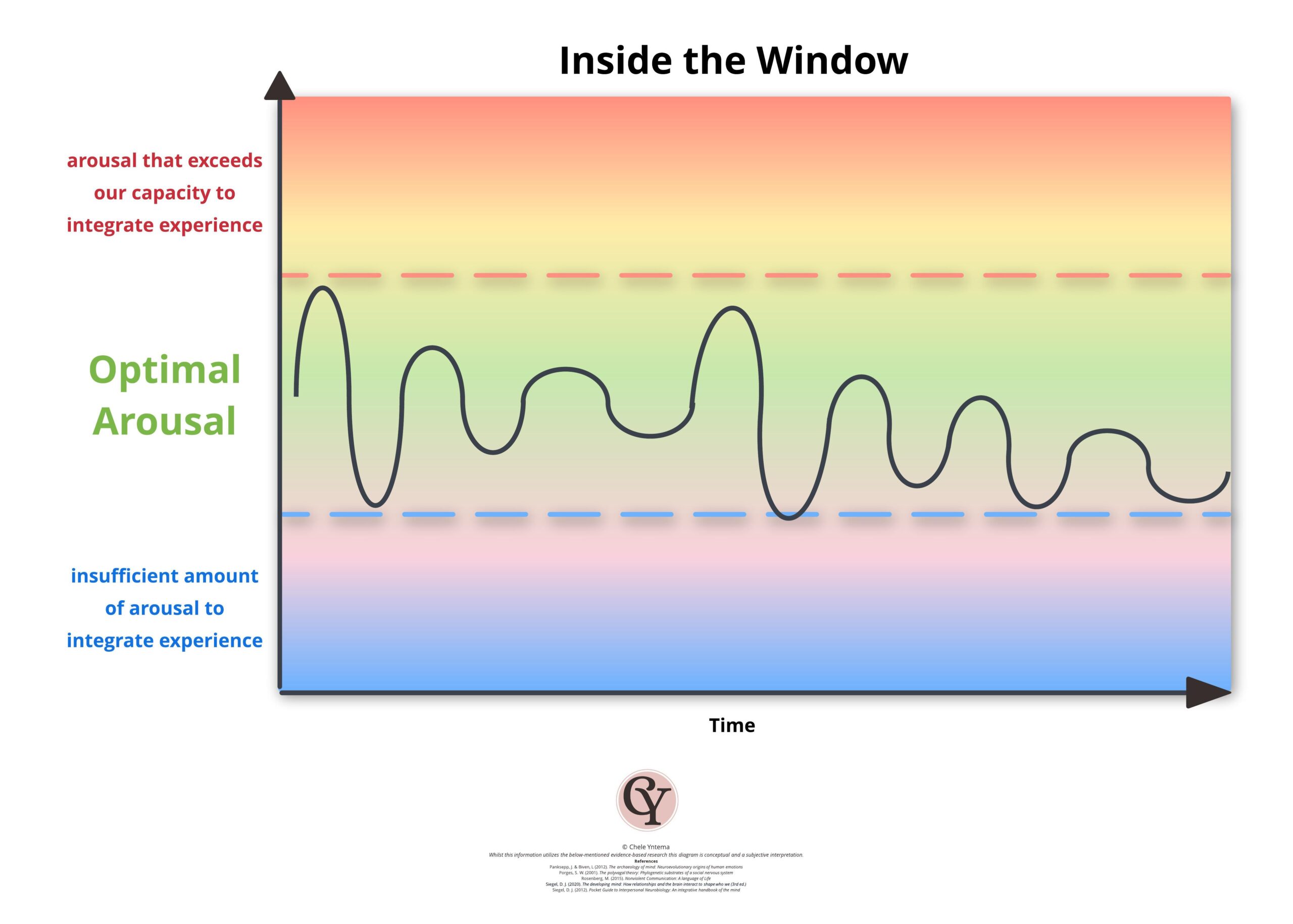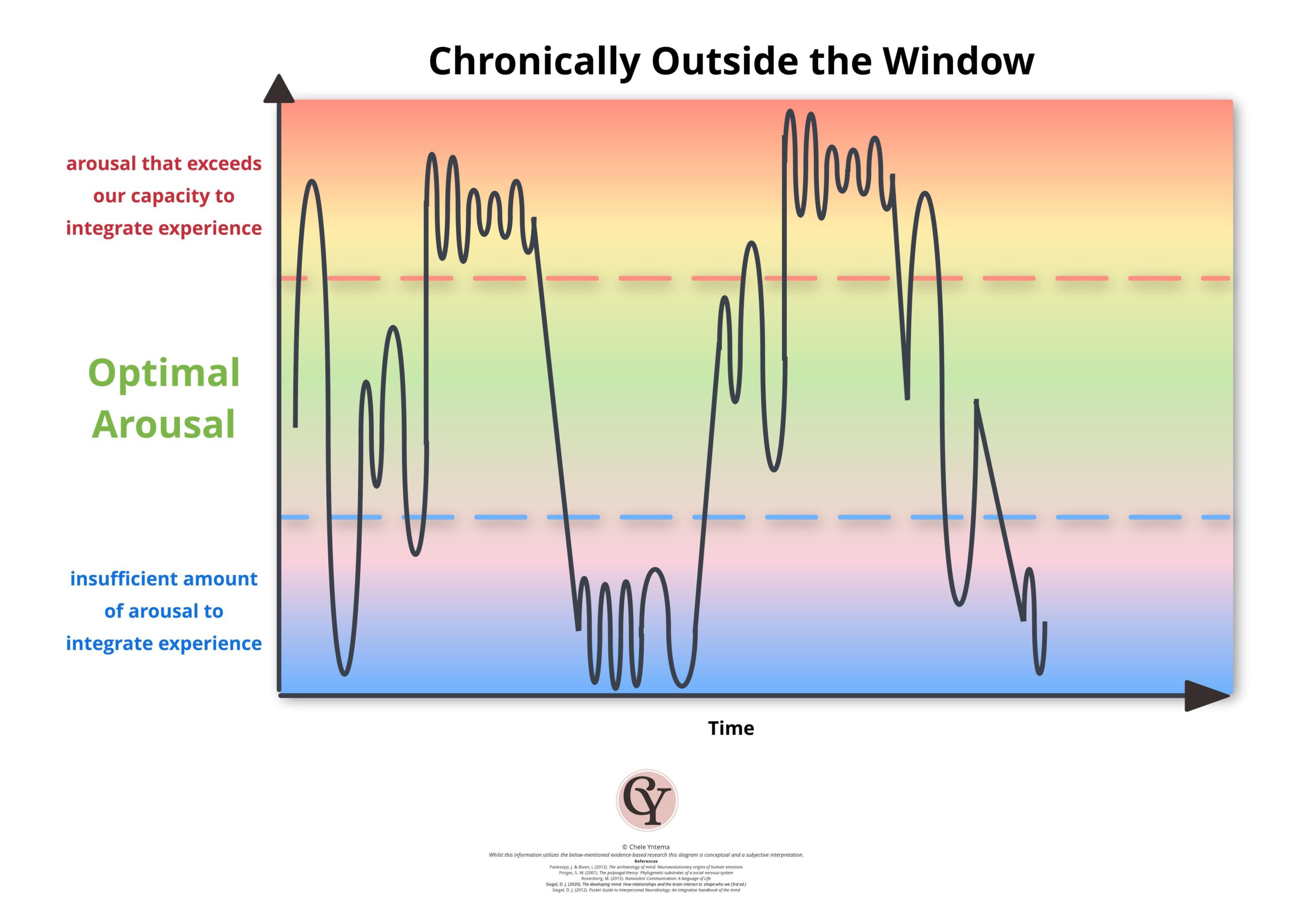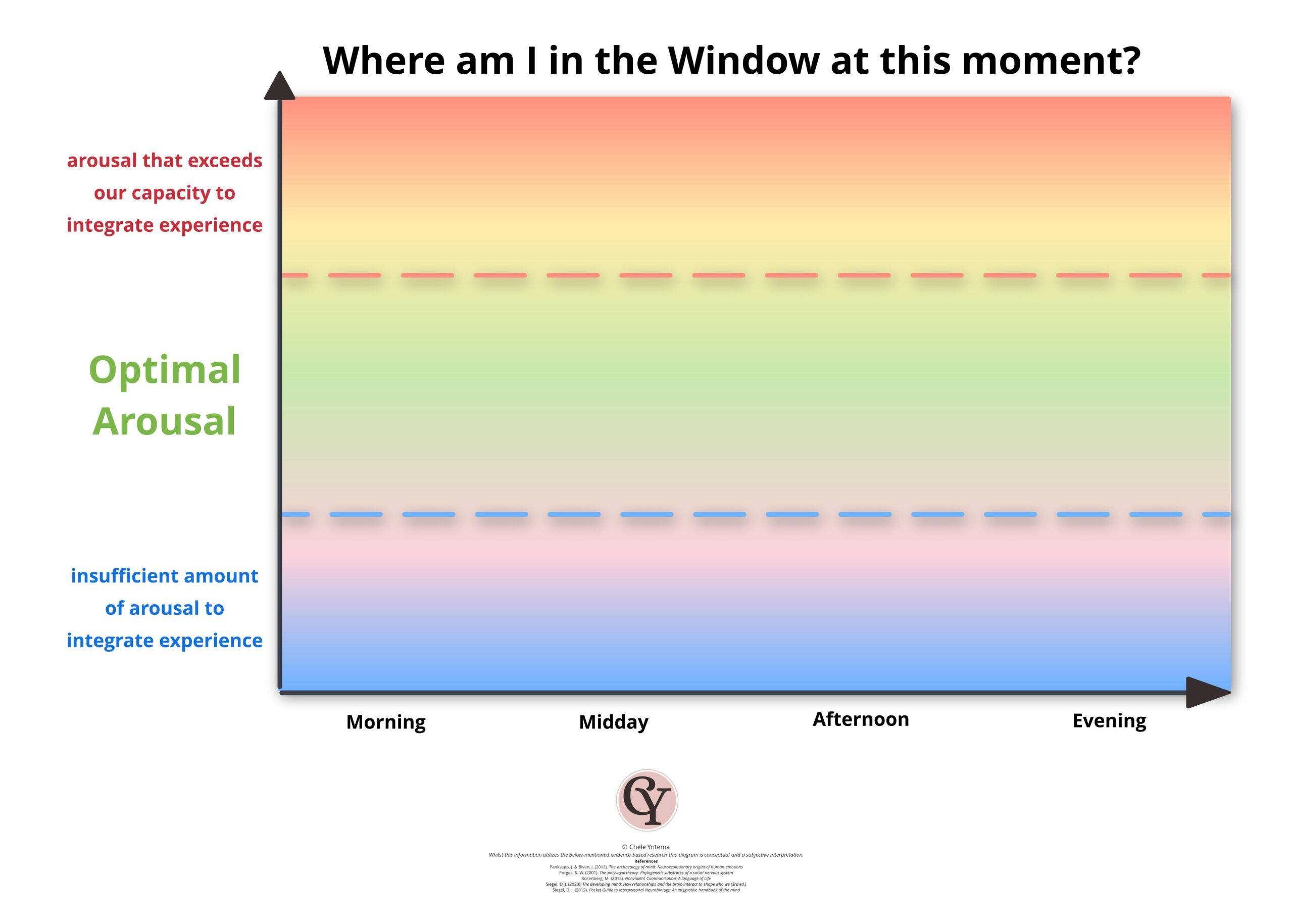Contents of Article
Have you ever been introduced to the Window of Tolerance?
It is a concept that was originally developed by the psychiatrist Dr. Dan Siegel as a way of conceptualising that our nervous systems each uniquely hold a band of optimum functioning wherein harmonious and adaptive flows of energy and information emerge from integrative processes (Siegel, 2020).
Whilst the notion of the window has been extensively embraced and adapted in a variety of health disciplines the central tenet remains the same: “that each of us has a [tolerable window of affect] in which various intensities, sensitivities, and specificities of emotional arousal can be processed without disrupting the functioning of the system” (Siegel, 2020).
This is a span of arousal wherein we can coherently and contextually engage with our affect (or the physiological stirring of emotion) whilst maintaining a harmonious and adaptive flow of integration (Siegel, 2012).
Most succinctly put, when we are within our window, we have a capacity to remain in contact, or in a state of presence, with our authentic sense of Self; we feel connected and calm, or safe-enough to process internal and external stimuli flexibly and congruently (Siegel, 2012).
Meaning, this safe-enough state ultimately allows us to be aware of, to recognise, to attune to, and to make sense of the physiological, psychological, and relational value of our emotive affect: it is this window of safe-enough presence that allows us to find the the meaning and purpose of the feelings that we are feeling. It is the capacity to see, to pause, to understand, and to act with intention and alignment with our authentic Self.
It is this unique capacity to remain in a state of presence alongside our capacity for connection to Self, Other, and the World that leads me to use the terminology ‘Window of Capacity’.
This semantic nuance is an important shift that highlights a compassionate approach whereby, rather than simply seeking to ‘tolerate’ intense affect, we can seek to acknowledge what we might truly have capacity for – moment-to-moment situationally and relationally.
To further our understanding of the Window of Capacity we might begin to unfold the notion neurobiologically. That is, when we are within the window both our somatic and autonomic systems (the peripheral nervous system) are working with equilibrium;more specifically however, the sympathetic and parasympathetic branches of the autonomous system are monitoring and modifying levels of arousal even amidst increased stressors – there is a felt sense of safety.

Importantly, when we are within the window even amidst a stressor our systems activate or deactivate in manners that allow us to respond with efficacy and efficiency and, when the stressor has past, to come back to a state of restful restoration. This autonomic monitoring and modifying may also be viewed as the micro-adjustments our systems make moment to moment to attend to our homeostatic neuroceptive needs. This can be seen as the window in which our systems can maintain the integrative capacity – physiologically, psychologically, and relationally – that allows us to engage with the world in a manner that is flexible, adaptive, coherent, energised, and stable (FACES, Siegel, 2020).
With this in mind, when we are outside the window, our nervous system might be working without a stable sense of equilibrium: our systems are unable to tolerate the level of arousal. Accordingly, we may autonomously shift either into states of hyperarousal or hypoarousal where our integrative capacity to respond effectively is reduced or impaired. In the face of a stressor our systems become confused and/or overwhelmed, and in moving into nonintegrative incoherence we then may react in manners that may not be congruent to our most authentic sense of Self.
States of hyperarousal can be seen as an arousal that exceeds our capacity to integrate experience. This is an excessive activation of protective mobilisation (an ongoing sense of danger or dread) wherein the sympathetic branch of our nervous system may be unable to come back down into safety or engagement; this may look or feel like hypervigilance, anxiety, impulsivity, reactivity, intrusive or over thinking, sleeplessness or restlessness, fidgeting, chaos, confusion, overwhelm, and/or the like – any form of physiological, psychological, and/or relational response that may hold an abundance of movement or action. Alternatively, we may understand this as an activated flight, flock, frenzy, fight, force, or freeze response.
More physiologically this is the release of neurotransmitters such as epinephrine and nor-epinephrine, potentially an increased release of glutamate and acetylcholine, as well as an increased release of glucose from the liver for increased energy. Further to this physiologically there is a dilation of the pupils to allow more light and improved vision, a dilation of bronchi and faster respiration, an acceleration of the heart and a more forceful heartbeat, an inhibition of saliva glands and a dry feeling mouth, cold extremities as blood flow is moved to more central organs, an inhibition of pancreas and intestines, as well as inhibition of urinary system. Paradoxically, whilst acute states of mobilisation may enhance immune functioning, in states of chronic sympathetic arousal there may be immune dysregulation or suppression.
Correspondingly, states of hypoarousal can be seen as an insufficient amount of arousal to integrate experience. This is an inhibition/deactivation of mobilised protection (an ongoing sense of inescapable threat) wherein the parasympathetic branch of our nervous system may be unable to activate back into mobilisation, safety, or engagement; this may look or feel like lethargy, apathy, helplessness, hopelessness, depression, inactivity, auto-pilot, memory loss, numbness, shame, embarrassment, hiding, withdrawing, non-responsiveness – any form of physiological, psychological, and/or relational response that may hold an absence of movement or action. Alternatively, we may understand this as a deactivated freak, feign, or flop response.
More physiologically this may be the release of neurotransmitters such as endogenous opioids and endocannabinoids, Gaba, endorphins, as well as an increased release of cortisol; this may look like the constriction of pupils that reduces vision, the constriction of bronchi and slower respiration, the reduction of the heart rate and a slowed beat, the stimulation of saliva glands and tear ducts, cold extremities as blood flow remains within vital organs. Further to this whilst acute states of immobilisation may enhance immune functioning, in states of chronic parasympathetic arousal (specifically within the dorsal vagal complex) there may be immune dysregulation or suppression.
Importantly, it cannot be negated that when our systems, either physiologically, psychologically, or relationally, are chronically outside of our window there are increased risks for illness and disease or disorder to emerge.
Therefore, with an understanding of our moment-to-moment capacity to connect to our Self, Other’s, and the World in a state of presence, or with awareness of safe-enough and the movement within that takes us beyond our window either in hyperarousal or hypoarousal, we are better able to attune to our needs and wisely agree (ahead of time) to give ourselves space to re-enter a window of capacity and thus the integrative ability that opens us to engagement with the world in a manner that is contextually coherent.
Identifying our Unique Window of Capacity
As named, each of us hold a unique capacity to remain in a state of presence alongside our capacity for connection to Self, Other, and the World. And, rather than simply seeking to ‘tolerate’ intense affect, we can seek to acknowledge what we might truly have capacity for – moment-to-moment situationally and relationally.
In order to do this it is thus important to identify what each of these states may look like for us, and over time cultivating an embodied awareness and a compassionate connection with our Self that enables us to sense the subtle shifts within our body and mind. With such awareness we come to better understand what our emotional states feel like, alongside what each emotion might be telling us about our values and vulnerabilities – what action our affect might directing us to take…
More so, when we are empowered to sense the subtle shifts within our body and mind we become aware of and thus can acknowledge when we may be beginning to move beyond our capacity, to take a moment of CARE, and to reconnect to our Self in resonant appreciate for what is uniquely true of us.
With that in mind I here offer some ‘tools’ that may help us to begin to cultivate both an embodied awareness of our window as well as a compassionate connection that enables us to monitor and modify the unique flows of energy and information within ourselves.
Things that may affect our unique window of capacity
Influence of the past: the elements of genetic and environmental influence that may have impacted the system and its capacity.
Sensitivity: the minimum amount of stimulus required to activate an initial orientation, appraisal, and arousal.
Intensity: the degree in the strength of an arousal in response to sensitivity and selectivity.
Specificity: the value and meaning assigned to a stimulus: pleasant / unpleasant, safety / danger / life threat.
Recognising States of Being – within or outside of the window?
Within the Window of Capacity: What might safety look or feel like for me?
What might safe feel like in my body and where might I feel it?
Think about a moment in time, a place, or a space where you have felt a sense of calm, connectedness, courage, confidence, curiosity, creativity, or compassion… Take a moment to close your eyes, breathing deep into your body take yourself there, wherever or whenever that may be; and as you take yourself there let any images that arise emerge. As these images emerge, feel into them with every sense of your embodied being. As you take another breath, and open your eyes, see if you can describe what this feels like, to give it a name, or to identify a specific image association.
This is your ideal. This is an optimal space of safety.
Outside the Window of Capacity: What might hyperarousal look or feel like for me?
What might hyperarousal feel like in my body and where might I feel it? Remember hyperarousal is when we are holding an abundance of activity and are unable to autonomously come back down into safety or engagement.
Hyperactivity can look like:
- hypervigilance
- anxiety
- impulsivity
- over thinking
- sleeplessness
- intrusive thoughts
- compulsion
- overwhelm
- restlessness
- fidgeting
- chaos
- confusion
- shaking
- addiction
- reactivity – flight
- reactivity – fight
What other physiological, psychological, and/or relational actions might you notice that hold an abundance of movement or action?
You may want to use this activity created by Abby Vanmuijen to map what happens within our body during states of hyperarousal:
Outside the Window of Capacity: What might hypoarousal look or feel like for me?
What might hypoarousal feel like in my body and where might I feel it? Remember hypoarousal is when we are unable to autonomously activate back into mobilisation, safety, or engagement.
Hypoactivity can look like:
- Lethargy
- Apathy
- Helplessness
- Hopelessness
- Depression
- Inactivity
- auto-pilot
- memory loss
- numbness
- shame
- embarrassment
- hiding
- withdrawing
- Reactivity – freak
- Reactivity – flop
- Reactivity – feign
What other physiological, psychological, and/or relational response that may hold an absence of movement or action might you notice?
Again, you may want to use this activity created by Abby Vanmuijen to map what happens within our body during states of hyperarousal:
Exploring safety, hyperarousal, and hypoarousal in more detail
Just as it is helpful to know what safe feels like from within, it is also helpful to know what various states outside of our window are. Therefore, it is important to begin to map various states of arousal. We may seek to do this by:
- Checking in with our body at various points of the day.
- Take a moment to notice the flows of energy and information within our body and mind – what am I thinking, what am I feeling, what might I need?
- Identifying where we might be in our window by placing a mark in either an imagined window or a journaled window.
Use the chart below to see if you can map your capacity throughout the day.
For a more extensive journaling activity you may wish to map out your day within the window making note of the following:
- The sensations: What might be happening in my body i.e. shoulders tight, holding breath.
- The perceptions: How do I perceive what is happening in my surrounds i.e. what do I assume/ expect; feared outcome.
- The interpretations: How do I interpret this situation semantically i.e. what is my internal dialogue.
You may even wish to name certain repeated activations as a ‘part’ of you. For example, you may have an ‘overthinking part’ that often emerges at nighttime when you perceive there is pressure to live up to others expectations. This part might use the words “if I do not… then I am…” “what if…” “I should…” “I must…”
Or you may notice times where a ‘hiding part’ emerges; this part may perceive others are disappointed or upset, this part may interpret certain situations as “impossible” or use words “I am not good enough” “I can’t do this”…
Now that we have begun to map what safety, hyperarousal, and hypoarousal may look like for us – which in time will allow us to notice when we are moving out of our window – we can begin to ground what a moment of care might look like.
When we ground what works for us with intention and awareness in moments of calm connection to our Self or an Other, we are more readily able to pause, and to utilise the new knowing when our affect is moving beyond what may be containable.
What might a moment of CARE look like?
A moment of CARE is a brief moment in which we notice that we are moving beyond our capacity, and we pause. Whether it be a micro-moment or a more macro-moment, the following CARE values are vital:
C – Compassion: connecting to our body and softening toward our limits rather than override them.
A – Attention: noticing the moment-to-moment shifts in sensation and coherence.
R – Reflection: understanding the meaning that may surround internal experiences its past shaping and relational context.
E – Embodied Action: taking aligned steps (pause, movement, rest, boundary) that honours our current capacity.
With this in mind, it is important that this moment of CARE holds value to you – this means it may be anything that works for you.
However, here are some suggestions that I find specifically activate the ventral branch of the parasympathetic nervous system (the ventral vagus complex).
- Splash your face with ice cold water, run an ice cube over your lips and forehead, or even try gargling some cold water
- If you are outdoors, close your eyes and notice the breeze blowing on your face or through your body.
- Have a smooth crystal or a rock you can keep readily available in your pocket, if you are out and about simply hold the stone in the palm of your hand feeling its weight, ,texture and temperature against your skin.
- Place your hand on your heart, taking in a breath that moves past your diaphragm and into your belly, as you exhale focus on extending your breath.
- Ask yourself: “if I were to move or adjust my physical body even 2% in the direction of comfort, what might I do?” (Amber Grey)
- If you are feeling significantly confused or moving toward dissociation try naming the following
- Where am I?
- What is today?
- What is the date?
- What is the month?
- What is the year?
- How old am I?
- What season is it?
And, should you have longer that just a micro-moment, perhaps you have a macro-moment, you may like to:
- Give yourself a butterfly hug or take 9 magic breaths:
- You may even like to try a sun-salutation:

- Alternatively, you may like to try a simple listening mindfulness practice:

Remember, there is no one key ‘tool’ or ‘technique’ that may allow you to easily come back into your window of capacity, and sometimes we need to connect to a Therapeutic Other to help us sift through all that takes us out of our window in chaos, confusion, and overwhelm.
This is about what we each uniquely need in a moment of overwhelm, and that is what makes us most wonderfully human.
 Welcome, my name is Chele, I am a therapist primarily specialising in Trauma – specifically as it presents as Burnout and Breakdown. As a psychotherapist & PACFA & CCAA Clinical Counsellor I work individually with beautiful humans such as yourself who feel alone, lost, confused, & overwhelmed; those of you who are longing for something different.
Welcome, my name is Chele, I am a therapist primarily specialising in Trauma – specifically as it presents as Burnout and Breakdown. As a psychotherapist & PACFA & CCAA Clinical Counsellor I work individually with beautiful humans such as yourself who feel alone, lost, confused, & overwhelmed; those of you who are longing for something different.
As such, I offer my knowledge, skills, and inherent gifts with ears that listen to hear, and a heart open to receive who you are, no matter the suffering you bring; to support you in an exploration of how your past has impacted you and the ways that shows up presently. Together we will rediscover your hope and your sense of Self; we will reconnect you to what matters reclaiming the joy and delight in life you so deserve.
I welcome you to view my services or connect with me to explore how I can assist you in your journey.





